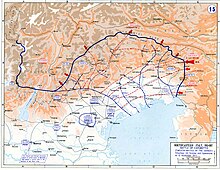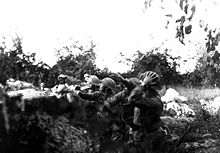Piave battles
Two unsuccessful attempts by Austria-Hungary to break through the Italian front in November 1917 and June 1918 and bring about a victorious end to the First World War are summarized under the term Piave battles . At the first attempt the Austrians were supported by the German Reich . The third battle of the Piave in October 1918 was already planned in the opposite direction and was led by the Italians. With the plural form Piave battles three battles are summarized, which from an operational point of view were completely independent of each other, on the lower Piave .
prehistory
As a result of the breakthrough of the Central Powers in the twelfth Battle of the Isonzo , also known as the Battle of Good Freit (Italian Battaglia di Caporetto ), the entire Italian front on the Isonzo and in the Carnic Alps was rolled up. On the breakthrough, the Italian 2nd Army was completely defeated. In order to avoid being encircled, the 3rd Army under Duke Emanuel of Aosta had to retreat from the lower Isonzo to the Tagliamento. The Italian mountain front in the Carnic Alps (Zona Carnia) also had to be dismantled in a hurry. Likewise, the 4th Army retreated from the Dolomites to Monte Grappa , where the Chief of Staff Luigi Cadorna had already established a reception position between the Asiago plateau and the Piave. The German-Austrian breakthrough on the upper Isonzo did not come to a standstill until the beginning of November on the Grappa massif and along the Piave to the Adriatic Sea.
At the Entente conferences in Treviso (October 30, 1917), Peschiera (November 8, 1917) and Rapallo (November 15, 1917), France ( Ferdinand Foch reluctantly) and Great Britain agreed to send about ten divisions , which they secretly did it was planned to intercept the German and Austro-Hungarian units after a possible breakthrough on the Piave in the Po Valley and to stop them in the western Alps, where a new front was to be established.
The Italian resistance on the Tagliamento collapsed since November 3rd, the German Alpine Corps crossed this river near Pinzano and operated in a westerly direction on Aviano following the kuk group " Krauss " .
From November 6th, the pursuing 14th Army tried to push through the enemy front between Brenta and Piave , which was slowly forming from Valsugana over the Grappa massif to the Piave. The Kraus group, closing up on the left, was supposed to advance south between Longarone and Belluno towards Feltre . The Austro-Hungarian Isonzo Army reached the Monticano sector on November 8th.
First battle of the Piave in November 1917


The first battle of the Piave began on November 10, 1917, the German-Austrian attack was successfully repulsed by the Italians by November 26, thanks to the bridges that were blown up in good time and thanks to the strong use of artillery.
The bulk of the 14th Army reached the Piave between Susegana and Feltre on November 9th . The Austro-Hungarian 22nd Rifle Division (Major General Müller) was able to build a bridgehead on the western bank of the Piave south of Longarone. The Austro-Hungarian 55th Division advanced against Belluno via Vittorio . The German 117th Division also reached the Piave, but was stopped by Italian artillery from proceeding. The Austro-Hungarian Army Group Boroevic closed up on the left as far as the mouth of the Piave on November 10th. In the 14th Army, the Imperial and Royal 55th Division (Major General Felix zu Schwarzenberg) reached Castione. The Piave bridges had already been blown up here, at Ponte nelle alpi and Cesana. The 50th Division (FML Karl Gerabek) reached the Piave near Bas and San Vito. Because of the blown bridges and the heavy artillery fire, the attempt to cross the river was not made. At Vidor , the German 12th Division under Major General Lequis tried to push in the existing Italian bridgehead and at the same time to advance with mass over the bridge. During the night this Italian beachhead was also abandoned and the bridge was blown up. The Austro-Hungarian 13th Rifle Division (FML Kalser ) reached the river at Nervesa and developed across the entire width of the eastern bank. Strong enemy forces and field fortifications were recognized on the opposite side.
The 14th Army threatened to overstretch the supply lines, as the last usable train station was in San Lucia near Tolmein . The Grappa massif developed south of Feltre and soon turned out to be an insurmountable obstacle. The Italian units had already evacuated the Feltre Basin, leaving almost all of the equipment behind, and thus escaped being gripped. On November 11th, the Piave was crossed in several places and bridgeheads were set up on the western bank. At Zenson at the mouth of the Piave (section of the 2nd Isonzoarnmee) the kuk 44th Rifle Division under FML von Iwanski succeeded on November 12 in the formation of a small bridgehead on the west bank of the Piave, which had to be abandoned on December 26.
The English and French divisions remained in reserve during the first phase of the Battle of the Piave between Brescia , Mantua and the Brenta . At the village of Vas, units of the Alpine Corps managed to cross the Piave on November 18, while the German Jäger Division (Colonel Georg von Wodkte) operated on Alano. To the left of the Jäger Division, the Alpine Corps was deployed opposite Monte Tomba until mid-December .
After it had been shown that the Italians could hold the front on the Piave and on the Grappa, the five British divisions were relocated to the Piave front on November 24th, the six French were only deployed from December 5th, among other things. a. on Monte Tomba.
After this attack was stopped, the Central Powers tried to force a breakthrough from the mountains near Asiago and Monte Grappa from December 4 to 23, 1917, but this again failed due to the Italian resistance. During this battle of the Piave, men born in 1899 who were not yet under conscription and sailors ( San Marco regiment ) fetched from the ships of the Italian navy fought on the Italian side .
After the first battle of the Piave, a limited Italian offensive north of Vicenza followed in late January 1918 . In March 1918, the British and French withdrew six of their eleven divisions from Italy . The Germans also moved their troops to the western front.
Ernest Hemingway had been a volunteer on the Italian front since the spring of 1918, was wounded during the second Battle of the Piave and processed his personal impressions and experiences together with reports from wounded in his novel A Farewell to Arms (Eng. In another country ; Switzerland ).
Second Battle of the Piave in June 1918
The Battle of the Piave began on June 15, 1918 with a large-scale Austrian artillery preparation from the Swiss border to the Adriatic . The focus of the Austrian attack was on the Asiago plateau , on the Grappa and on the lower Piave, but there was no clear focus in this southern main operating room. Austrian bridgeheads on the west bank of the Piave, in front of Treviso , had to be withdrawn under heavy Italian artillery fire. Also to at the Piave band since November 1917 Lagoon of Venice existing bridgehead did not last.
There was heavy fighting on the Montello, a hill at the exit of the Piave from the Alps , and especially on the Monte Grappa and the neighboring Col Moschin. There it succeeded only through the use of special forces of the Italian IX. Corps to prevent an Austrian breakthrough into the lowlands. The emaciated soldiers of the Danube Monarchy fought with the courage of desperation because they knew that it was their last chance to end the war successfully and, above all, quickly. But the Italian soldiers also gave everything, because it was no longer about a breakthrough on the Isonzo, but about defending their own country. Ultimately, the Austrian attack got stuck in the Italian defensive fire. The battle ended on June 22, 1918.
Propagandistic help was given to the Italians by the "Inter-Allied Propaganda Commission" of Crewe House . Because of the overflowing of ethnic groups, the Crewe House attributed itself a share of the victory in the second Battle of the Piave due to its propagandistic decomposition. Armando Diaz personally thanked committee members.
Third Battle of the Piave in autumn 1918

The third Battle of the Piave began on October 24th, 1918 and ended on November 3rd and 4th, 1918 with the armistice at Villa Giusti near Padua . Overcoming the Piave in the lowlands was initially associated with considerable difficulties for the Italian army . Floods destroyed many of the pioneers' bridges. But the sickle-like cut on Vittorio Veneto (the name suffix “Veneto” was added in 1923) meant the end for the Austro-Hungarian army . The Austrian troops defended their positions on Monte Grappa to the end. According to its own information, Italy had almost 40,000 dead and wounded in this last battle, most of which fell around the Grappa massif.
output
With the armistice of Villa Giusti on November 3, 1918, the opponents set the cessation of fighting for November 4 at 3 p.m. Since Hungary had no longer been linked to Austria in a Real Union since November 1, 1918 , it did not feel affected by this armistice; it negotiated separately with the Entente and concluded a military convention with it on November 13, 1918 in Belgrade . As a result of incorrect communication and timing among the Austrians, the Italians used the time to bring in a large number of prisoners of war. Almost the entire Austro-Hungarian Army Group in Tyrol was cut off as a result and was taken prisoner.
literature
- Austria-Hungary's last war. Volume VII, Verlag der Militärwissenschaftlichen Mitteilungen, Vienna 1938.
- Anton Wagner: The First World War. Troop service paperback, Verlag Carl Ueberreuter, Vienna 1981.
- Heinz von Lichem : War in the Alps 1915-1918. Volume 3, Weltbild Verlag, Augsburg 1993.
- Manfried Rauchsteiner: The death of the double-headed eagle. Austria-Hungary and the First World War. Styria, Graz, Vienna, Cologne 1993.
- Ingomar Pust: The stone front. From the Isonzo to the Piave. On the trail of the mountain war in the Julian Alps. Ares Verlag, Graz, 3rd edition 2009. ISBN 978-3-902475-62-6 .
